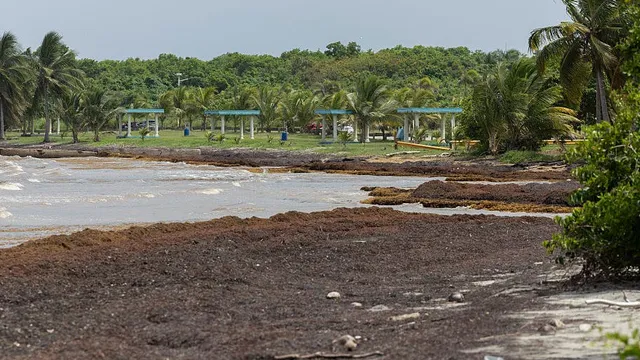
Record levels of sargassum threaten Caribbean tourism and coastal ecosystems
2025-06-05 21:46- A record amount of sargassum, 38 million metric tons, was reported across the Caribbean in May 2025.
- The unusual volume has raised concerns for coastal ecosystems and impacted tourism-dependent local economies.
- Experts caution that without adequate measures, the continuing growth of sargassum could worsen in future years.
Express your sentiment!
Insights
In May 2025, Puerto Rico and the surrounding Caribbean regions faced an unprecedented influx of sargassum seaweed, totaling 38 million metric tons. This amount marks the highest recorded since the monitoring of the Great Atlantic Sargassum Belt began in 2011. The drastic increase from the previous year's record of 22 million metric tons has raised concerns among biologists and environmentalists regarding the factors contributing to this phenomenon. Although the precise causes remain uncertain, hypotheses include climate change, agricultural runoff, and alterations in local ocean currents and winds. Despite serving as a vital ecosystem for marine life in the open ocean, the sargassum's encroachment on shore poses significant challenges for coastal communities. As the seaweed clogs beaches and produces foul odors when decomposing, it disrupts tourism, a critical economic driver for numerous Caribbean islands. Regions like Punta Cana in the Dominican Republic have taken precautionary measures such as installing barriers to mitigate the arrival of sargassum, while other areas have initiated emergency clean-up operations to address the situation. The impact extends beyond environmental concerns; local governments are pressured to allocate funds for cleanup efforts, further straining resources in regions that already struggle financially. Some hotels are taking an active role in mitigating effects by offering guests alternative beach options, reflecting the operational upheaval within the tourism sector. Additionally, in St. Maarten, residents experienced severe fumes related to the seaweed's decay, highlighting health concerns associated with significant sargassum influxes. As summer approaches, experts continue to monitor the situation, forecasting an ongoing rise in sargassum amounts during June, particularly within the western Caribbean and Gulf regions. This pattern of frequent sargassum blooms has prompted discussions about the environmental and economic sustainability of tourism-dependent regions, as both experts and local authorities grapple with diminishing resources for adapting to and managing this natural phenomenon. The context of the increasing sargassum in the Caribbean emphasizes a need for broader conversations about climate-related changes impacting marine ecosystems and coastal economies.
Contexts
Sargassum blooms are large accumulations of seaweed that primarily occur in tropical and subtropical regions, particularly in the Atlantic Ocean. These blooms are made up of floating sargassum, a type of brown algae that thrives in warm waters. Understanding the causes of these blooms is crucial for managing the ecological impacts they have on marine environments, coastal tourism, and local economies. The primary drivers of sargassum blooms include nutrient pollution, changes in ocean currents, and climate change. Nutrient pollution, often a result of agricultural runoff, sewage, and other human activities, provides the necessary conditions for sargassum to flourish by fueling its growth with excess nitrogen and phosphorus. This, in conjunction with the warmer temperatures associated with climate change, creates a favorable environment for these blooms to proliferate. Moreover, shifts in ocean currents and environmental conditions have also been linked to the emergence and spread of sargassum. Regions such as the Caribbean have experienced alterations in water circulation patterns due to changes in wind patterns and ocean temperatures. These changes can contribute to the accumulation and proliferation of sargassum at specific locations. Understanding these oceanic and atmospheric variations is essential in predicting where and when sargassum blooms will occur, and helps in developing strategies to mitigate their impacts on coastal ecosystems. The timing and frequency of sargassum blooms can vary significantly from year to year, influenced by seasonal and regional environmental factors. Researchers have observed that larger blooms are more likely to occur following periods of heavy rainfall, which can increase nutrient runoff into the ocean. Additionally, sargassum's reproduction and growth are also tied to biological factors, such as its life cycle and interaction with other marine organisms. The life cycle of sargassum involves both asexual reproduction and fragmentation, allowing it to rapidly expand in ideal conditions, further compounding the challenges of managing blooms. In summary, the causes of sargassum blooms are rooted in a complex interplay of human activity, natural environmental changes, and climate conditions. It is imperative for researchers and policymakers to work collaboratively in monitoring these blooms and understanding their underlying causes in order to devise effective management strategies. Addressing the contributing factors like nutrient pollution and ecological changes will be key to mitigating future blooms and protecting the marine environments and communities that rely on healthy oceanic ecosystems.